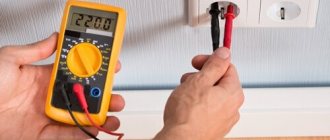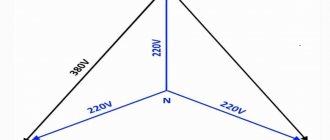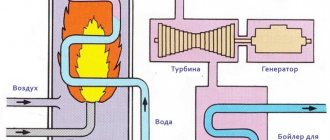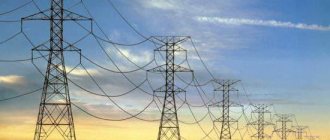What is high voltage?
In any electrical network, be it household, industrial or high-voltage, there is a set level - 220V, 380V, 6 - 10 kV and others. These parameters must be within strictly established limits, not exceeding 5% of the norm for a long time and 10% for a short time. But in practice, there are situations when high voltage in the network may occur, exceeding the nominal value by 20%, 30% or more. Which creates a threat to electrical devices and humans in the event of a device breakdown and potential transfer to their housing. The reason for this increase may be various processes in the network.
What to do if there is increased voltage
The exit routes are as follows. 1. Call a representative of the energy supply organization to carry out control measurements, based on the results of which a report should be drawn up. Action must be taken on this act, or you can refuse to pay for the energy consumed for reasons of unsatisfactory quality.
2. Distribute (reconnect) temporarily the load from the second phase to 1 and 3 phases.
3. Install a voltage stabilizer on the 2nd phase, this will lower the voltage to normal and completely eliminate the problem. Moreover, this will improve the voltage stability in case of voltage drops at the input from 130 to 270 V. The issue price (minimum) is 14,000 for a 10 kW stabilizer plus 3,000 rubles for materials and installation work. Total – 17 tr.
4. Ignore the problem by setting the max. the voltage relay limit for the 2nd phase is at the level of 257...259 Volts, so that it does not work often.
Switchgear and substation transformers. These are installed in a small area.
Another option is to insist that the voltage at the output of the energy substation transformer be switched to a lower one. But, as already mentioned, residents of distant houses may suffer.
Transformer substation label
Or, connect to a neighboring street if it is powered by another transformer.
Causes
In practice, both low and high voltage in the network have a number of negative consequences for household electrical appliances. Regardless of the level of the rated voltage in the network, an increase can occur for the following reasons:
- Artificial adjustment of the output level using an on-load tap-changer or tap-changer at a substation or package transformer substation. Due to frequent complaints about low voltage, the power supply organization increases the output parameter. As a result, in the last house connected to the line, the input voltage will correspond to the norm, and in the first it will significantly exceed.
- In addition, high voltage occurs during seasonal changes, the transition from day to night, changes in operating cycles of powerful equipment, etc. When the amount of electrical energy consumed differs significantly at the peak of the cycles. For example, in winter or before the start of centralized heating, household electrical networks suffer from numerous heating devices that cause low voltage. If at the same time the adjustment is made upward, then with warming a fairly large potential will arise on the transformer windings.
- Phase imbalance is caused by both damage to the network (for example, a break in the neutral wire) and a significant difference in the connected power to each line. At the same time, in some of the phases the alternating current increases and the voltage decreases, and in the neighboring phases, on the contrary, high voltage appears.
Rice. 1. phase imbalance - Emergency situation - due to damage in the networks, for example, a phase falling to zero, the potential difference will increase to a linear level. That is, instead of 220 V, 380 V will be supplied to household appliances. An identically high voltage can occur when the insulation breaks down between the high and low sides, when one of the phases breaks and zero-sequence currents occur.
Negative phenomena in the electrical network - their impact on the load and methods of combating
This article will discuss the general principles of the functioning of the electrical network, the negative processes occurring on power supply lines and various methods of protecting terminal equipment.
Unified Energy System
Almost all power plants in Russia are united into a single federal energy system, which is the source of electrical energy for most consumers. The most important and indispensable component of any power plant is a three-phase alternating current turbogenerator. The three power windings of the generator induce a line voltage. The windings are symmetrically located around the circumference of the generator. The generator rotor rotates at a speed of 3000 rpm, and the linear voltages are shifted relative to each other in phase. The phase shift is constant and equal to 120 degrees. The alternating current frequency at the generator output depends on the rotor rotation speed, and is nominally 50 Hz.
The voltage between the line wires of a three-phase AC system is called line voltage. The voltage between the neutral and any of the line wires is called phase. It is a root of three times less than linear. It is this voltage (phase 220 V) that is supplied to the residential sector. Line voltage 380 V is used to power high-power industrial equipment. The generator produces a voltage of several tens of kilovolts. To transmit electricity, in order to reduce losses, the voltage is increased at transformer substations and supplied to Power Transmission Lines (hereinafter referred to as power lines). The voltage in power lines ranges from 35 kV for short lines, to 1200 kV for lines over 1000 km long. The voltage is increased in order to reduce losses, which directly depend on the current strength. On the other hand, the voltage is limited by the ability to insulate the air for power lines and the cable dielectric for cable lines. Having reached a large consumer (factory, populated area), the electricity again enters the transformer substation, where it is transformed into 6–10 kV, which is already suitable for transmission via underground cables. Each multi-apartment residential building or administrative building has a transformer substation, which outputs 380 V of linear voltage and, accordingly, 220 V of phase voltage intended for the consumer. Typically, two or three high-voltage cables are inserted into a substation, which makes it possible to quickly restore power supply in the event of damage on the high-voltage section of the route. Depending on the type of substation, this can happen automatically, semi-automatically - at the command of the dispatcher from the central console, and manually - an emergency crew arrives and the electrician switches the switch. The substation can also serve as a voltage regulator, switching the transformer windings depending on the load. In Russia, substations use a circuit with a grounded neutral, that is, the neutral (often called neutral) wire is grounded. Cable distribution throughout the building occurs in phases, both in order to parallelize the load and to reduce the cost of equipment (meters, circuit breakers). A substation in rural areas and for small houses is usually a transformer booth or simply an external transformer. That is why it takes a day to correct an accident in such a place. Such substations do not have automatic voltage regulation, and usually provide the nominal voltage during periods of minimal load, lowering the voltage the rest of the time.
Quality standards for electrical networks
The document establishing power quality standards in Russia is GOST 13109-97, adopted on January 1, 1999. In particular, it establishes the following “ standards for the quality of electrical energy in general-purpose power supply systems .”
| Parameter | Denomination | Extremely |
| Voltage, V | 220V ±5% | 220V ±10% |
| Frequency, Hz | 50 ±0,2 | 50 ±0,4 |
| Distortion, % | 8 | 12 |
| Dips, sec | 3 | 30 |
| Overvoltage, V | 280 | 380 |
Thus, even during normal operation of the power grid, the use of UPS devices for computer equipment is mandatory, both to protect the integrity of data and to ensure the health of the equipment. From the point of view of power supply, all consumers are divided into three categories. For the largest category of our readers, those living in buildings with more than eight apartments or working in office buildings with more than 50 employees, the second category is relevant. This means a maximum troubleshooting time of one hour and a reliability of 0.9999. The third category is characterized by an emergency resolution time of 24 hours and a reliability of 0.9973. The first category requires a reliability of 1 and a troubleshooting time of 0.
Types of negative impacts in the electrical network
All negative impacts in the electrical network are divided into dips and overvoltages.
Pulse dips are usually caused by overloading of the terminal lines. Turning on a powerful consumer, such as an air conditioner, refrigerator, or welding machine, causes a short-term (up to 1-2 s) drop in the supply voltage by 10–20%. A short circuit in a neighboring office or apartment can cause a pulse failure if you are connected to one phase. Pulse dips are not compensated by the substation and can cause failures and reboots of computer and other electronics-rich equipment.
A permanent dip, that is, a constantly or cyclically low voltage, is usually caused by an overload of the line from the substation to the consumer, poor condition of the substation transformer or connecting cables. Low voltage negatively affects the operation of equipment such as air conditioners, laser printers and copiers, and microwave ovens.
A complete failure (blackout) is a loss of voltage in the network. According to the standard, any equipment must withstand a loss of up to one half-cycle (10 ms) without disruption. At old-style substations, switching of the voltage regulator or reserve can take several seconds. Such a failure looks like “the light blinked.” In such a situation, all unprotected computer equipment will “reboot” or “freeze.”
Constant overvoltage - overvoltage or cyclically overvoltage. Usually it is a consequence of the so-called “phase imbalance” - uneven load on different phases of the substation transformer. In this case, a constant dip occurs on the loaded phase, and a constant overvoltage occurs on the other two. Overvoltage greatly reduces the service life of a variety of equipment, starting from incandescent light bulbs... The likelihood of complex equipment failing when turned on increases significantly. The most unpleasant constant overvoltage is the burning out of the neutral wire, zero. In this case, the voltage on the equipment can reach 380 V, and this practically guarantees its failure.
Temporary overvoltage can be pulsed and high-frequency.
Pulse overvoltage can occur when the phase conductors of a power cable are shorted to each other and to the neutral, when the neutral is broken, when the high-voltage part of the substation transformer breaks down to the low-voltage part (up to 10 kV), when lightning strikes the cable, substation or near them. The most dangerous surges are for electronic equipment.
High-frequency overvoltage is characterized by the presence of parasitic high-frequency oscillations in the power cable. May interfere with the operation of highly sensitive measuring and recording equipment.
Ways to counteract negative influences
The table below summarizes all types of negative impacts in the electrical network and technical methods to combat them.
| Type of negative impact | Consequence of negative impact | Recommended protection measures |
| Pulse voltage dip | Malfunction of equipment containing microprocessors. Loss of data in computer systems. | High quality power supplies. Online UPS |
| Constant failure (underestimation) of voltage | Overloading equipment containing electric motors. Inefficiency of electric heating and lighting. | Autotransformer voltage regulators. Switching power supplies. |
| Voltage failure | Turning off the equipment. Loss of data in computer systems. | Battery UPS of any type to prevent data loss. Autonomous generators, if necessary, to ensure uninterrupted operation of equipment. |
| Overvoltage | Equipment overload. Increased likelihood of failure. | Autotransformer voltage regulators. Surge filters with surge protection circuit breaker. |
| Pulse overvoltages | Malfunction of equipment containing microprocessors. Loss of data in computer systems. Equipment failure. | Surge filters with surge protection circuit breaker. |
| High frequency overvoltages. | Disturbances in the operation of highly sensitive measuring and sound recording equipment. | Surge filters with low-pass filters. Isolation transformers. |
| Phase imbalance (phase voltage difference) | Overload of three-phase equipment. | Load equalization by phases. Maintaining the power cable network in good working order. |
| Mains frequency deviation | Malfunction of equipment with synchronous motors and products dependent on the network frequency. | Online UPS. Replacement of outdated equipment. |
It should be noted that modern high-quality UPSs include a surge protector and a voltage limiter. The reaction and switching time to the battery is short enough to ensure reliable, uninterrupted operation of any electronic devices. The use of separate stabilizers can be justified when there is a large amount of equipment, since the price of a 10 kW stabilizer is approximately equal to the price of a 1 kW UPS. Using a separate surge protector is much less justified. UPSs are not intended for systems requiring continuous operation. If the power of such equipment exceeds 1 kW, the optimal solution would be to use an autonomous diesel generator.
Consequences
As a result of the occurrence of high voltage beyond permissible fluctuations, all kinds of household, power and electronic devices experience significant overload. This can cause various problems in their operation. Among the most significant consequences are:
- Failure - if the potential increases above 250 V, electronic units and microcircuits of various devices may burn out.
- Increase in current and overheating - when the voltage fluctuates upward with the same section resistance, the rated current increases proportionally. This causes excessive heating of the conductors and can lead to a fire. This consequence is especially dangerous for all lighting devices.
- Violation of normal operation is typical for electrical machines and high-precision devices, the operation of which is regulated by strict adherence to the parameters of the electricity consumed.
- Reduced service life - due to an increase in potential difference and overheating, premature aging of the insulation occurs, which leads to breakdown or failure of some functions.
It should be noted that most expensive modern devices are equipped with indicators for voltage drops, current surges and other deviations beyond acceptable limits. Because of this, if such devices fail due to high voltage, the manufacturer has every right to refuse its own warranty obligations. Therefore, to prevent financial waste on restoration from such impacts, measures should be taken to bring the network parameters back to normal.
The concept of the norm and excessively low or high indicators
Any electrical equipment is designed for a certain electrical voltage. Optimal operation of devices occurs at the nominal value of this parameter. Voltage is considered excessively low if it is not capable of starting an electric motor, lighting a lamp, or heating a coil, i.e. such a value at which the electrical appliance does not work or cannot achieve the required characteristics.
With such a power supply, the equipment simply turns off or does not turn on. Excessively high voltage is considered to be capable of causing insulation breakdown or unacceptable heating of current conductors. This is the most dangerous option. It can cause equipment failure if adequate protection is not provided. The rated voltage value is set depending on the accepted standards and purpose in the network.
For household networks in the Russian Federation, in accordance with GOST, the nominal value of the electrical voltage is 220V.
Its value is considered to be excessively low or high if it differs by 10% from the nominal value downwards or upwards, respectively.
Measures to normalize the voltage level in the network
Depending on the location of the impact, measures aimed at combating high voltage can be general, affecting the entire network, and local, applied to a specific consumer. Please note that for local measures, for example, at home or in an emergency, there is no need to coordinate the installation of the stabilizer with the electricity supplier. While general measures require contacting certain authorities.
Where to complain to solve the problem?
If the mains voltage is high, you can submit a corresponding request to the regulatory authorities to take action. This could be local city or village councils or the electricity supply organization directly. The first option is the most effective, since their function is to control the operation of the same RES. But due to the large number of transmission links, contacting local authorities is a lengthy procedure.
To contact the power supply organization, you need to not only report high voltage at your own connection, but also inquire about this parameter from neighboring consumers. Since if others are satisfied with the level, or one of them complains about low voltage, then they will definitely not lower it further.
As a rule, the Distribution Zone is in no hurry to respond to single requests that consider the interests of one consumer, but can affect the three-phase current for the entire group or area. Moreover, before this they could already make adjustments at the request of other persons. Therefore, in such cases, the fastest option to combat high potential differences is to install stabilizers and other protective devices.
How to reduce high voltage at home?
If you cannot influence the voltage level through a written request or it simply does not give the desired result, then it is necessary to install protection devices. Among the most common options are:
- Surge filter – allows you to eliminate short-term surge voltages. It is divided into several categories, depending on the complexity of the device and the specific operation of the protected object. Its disadvantage is the inability to eliminate long-term overvoltage in the network.
- Voltage regulator – allows you to change the value of high or low voltage at the input to the nominal value. This ensures not only ideal power supply to the consumer, but also its protection from emergency conditions - surges in electric current due to atmospheric overvoltages, short circuits, etc.
Figure 2: Normalization using stabilizer - Voltage control relay - disconnects all devices from the network in which low or high voltage has crossed the permissible deviation level. The natural drawback of the device is that it does not solve the problem of long-term increase in potential. And after switching the relay, you need to turn it back on yourself.
When installing automation that independently cuts off power in the event of overvoltage detection, uninterruptible power supplies can be used to restore power supply. Which will continue to power the equipment until the potential in the network normalizes.
Rice. 3. Example of turning on an uninterruptible power supply
What to do if the voltage is low.
The most common case is when the voltage in the house is greatly underestimated. This occurs mainly in the private sector; old thin long wires with significant resistance come to houses.
As we know from Ohm's law, the greater the current, the more the voltage drops on the wires. After all, wires have resistance.
As we know, there is no money to globally correct the situation by changing the supply lines. Therefore, everyone gets out of the situation as best they can. Namely, there are two options:
- connect and make an input from another line, or phase. Or lay a separate SIP from the substation. This may not always be technically and financially possible.
- install a voltage stabilizer that will “pull” the voltage to normal.
In 99% of cases, people go for option 2 because it is easier, faster and cheaper.
What does this lead to? The voltage in the house will, of course, rise to acceptable limits, thanks to the efforts of the stabilizer. However, energy cannot be taken from nowhere - the voltage at the output of the stabilizer increases due to an increase in the current at its input. This means that there is also current in all wires BEFORE the stabilizer, starting from the 0.4 kV substation. And the current is greater - which means the voltage drop is also greater, and the voltage for those who did not install a stabilizer is less! That is, installing stabilizers aggravates the situation as a whole.
By the way, an important note! If the stabilizer is installed in a house where there is often low voltage, then you need to take into account that the current at its input can increase greatly, sometimes by 2.5 times! Therefore, the cross-section of the input wires should be a step or two larger than the output wires.
And the output wires, of course, are selected from the load.
In general, the main idea is that before eliminating the consequences of low or high voltage, think about eliminating the cause.
How do you solve these problems? Share and ask questions in the comments.
Typical frequently asked questions from readers
I connected the LIEBHERR {CUN3033} refrigerator via a PH-122 voltage relay. For about a week everything was fine, the network voltage was within the upper limit, the factory setting was 250 volts, and the refrigerator was working. But from December 31 to this day, the relay shows 250-253 volts and the refrigerator is turned off for approximately 5 hours a day. And at night I don’t even know how it works. Please tell me, is it possible to set the upper limit on the relay to 255 volts or is this unacceptable for a refrigerator? Could the relay be faulty? And why is there such high voltage in the network in an apartment in Moscow, or is this the norm? Please advise what to do? And also, the relay gets warm, a little, but the body is warm, is this normal or not?
As I understand it, you installed the RN-122 voltage control relay in the plug socket for connecting the refrigerator.
There are many questions, but let's consider everything in order. If we consider the permissible response limits, then, in accordance with the passport data, the regulation range for Umax is from 230 to 290 V. Therefore, yes, you can set the maximum voltage limit to more than 250 V. The fact that you have a maximum Umax limit of 250 V indicates about using factory settings (for voltage control relay RN-122, the response threshold for the minimum voltage is 185 V, and for the maximum voltage is 250 V). To change the value of the maximum response threshold, you need to perform the following steps (see the figure on the link):
Regarding the rated voltage, in accordance with GOST 32144-2013, the maximum limit is 253 V (that is, +10% to 230 V). But for many household appliances this is too much. I recommend that you double-check it with a multimeter or voltmeter; if this is indeed the case, contact the management company with an official statement. Otherwise, the relay may actually be faulty and simply needs to be replaced.
Why is this dangerous?
Any significant deviations in electrical voltage from the norm significantly affect the performance and service life of most household appliances. The danger comes from both excessively high levels and voltage drops, as well as its constant fluctuation within a wide range.
Equipment with electric motors suffers especially often. At low voltages they are overloaded, which reduces their lifespan. Deviation from the norms can cause the following problems:
- frequent lamp burnouts;
- burnout of heating elements at high voltage;
- breakdown of insulation of windings, wires and cables, electronic elements at excessively high voltage;
- premature failure of refrigerators, washing machines and other equipment with electric motors due to frequent and prolonged voltage drops, as well as prolonged drops;
- reduction in the service life of household appliances, incl. TVs, microwave ovens, computers, with an unstable network.
It is important to understand that it is not only sudden increases in voltage that cause immediate equipment failure that are dangerous.
Long-term operation at low voltage and constant fluctuations can lead to serious problems with devices of any class.
The voltage in the house dropped to 160 volts
Electrical voltage of 160–180 volts is a very common problem that is familiar to many owners of private houses and cottages. Such a low voltage is not enough even for the normal functioning of lighting devices.
It is very easy to determine who is causing the problem. If insufficient voltage is supplied to the power line, then the fault falls on the service provider, and if the problem is noted only on the branch to a private house, then only the consumer is responsible for this.
You can check what exactly is the cause of insufficient voltage yourself by contacting the neighbors of nearby houses. If a similar problem does not bother them, then it is absolutely clear that the voltage drop occurs precisely on the branch from the power line to the house.
The main sign of a faulty power input is a sharp drop in voltage when devices with high power consumption are simultaneously connected to the network. Everyone is familiar with the situation when devices turn off or the circuit breakers on the control panel are knocked out.
Reasons for decreasing input voltage and its elimination
Firstly, the voltage may drop due to the cross-section (thickness) of the wires being too small. Thin wires are not able to withstand heavy loads.
Secondly, subsidence may occur due to poor contact on the branch. Such contact forms excessive resistance in the network, due to which the final voltage decreases.
The danger of such malfunctions lies in excessive heating of the wires or the place where the bad contact is located, which is formed due to loss of voltage in the network. A hot faulty contact can subsequently lead to a complete blackout of the house or a fire.
Very often, the junction of the power line and the outlet is connected by conventional twisting, which is an extremely unsafe option. In this case, only natural cooling of the wires saves the owners of the house from a full-fledged fire.
Ideally, power lines and inputs should be connected using clamps, which are safer and more reliable than all other connection options. However, often even factory clamps can become unusable and produce sparks and heat, which are observed at maximum load on the wiring. Of course, if a malfunction is detected, the clamp must be urgently replaced.
Sometimes a contact fault is detected on the device that connects the house panel and the branch wires. In this case, the voltage loss can be eliminated only by replacing this device.
Low voltage on power lines
Voltage sags on power lines for which the electricity supplier is responsible can occur in the following cases:
- Overvoltage at the substation.
- Insufficient cross-section of wires on the line.
- Uneven distribution of phase loads at the substation.
Today, when almost all old substations have been replaced with new ones, it is almost impossible for an overload to occur at them. This is due to the installation of effective relay protection on modern models. Outdated substations remained operational only in the most remote villages and populated areas. Eliminating subsidence due to overloads is only possible by replacing the substation itself.
A voltage drop due to uneven phase loads at a substation is an unstable phenomenon, which will be very difficult to prove to residents of the private sector.
Insufficient cross-section of power line wires most often causes low voltage. The fact is that for a long time such wires were chosen for equipment because of their low cost.
Several decades ago, this cross-section of wires was quite sufficient for normal power supply to the private sector. Now that almost everything runs on electricity, the wires can no longer withstand such loads and require replacement. This problem is especially evident during the day, when all residents use electrical appliances at the same time, and at night the situation stabilizes.
Of course, problems on the power line should be dealt with directly by the utility provider, but, unfortunately, many private sector residents live with insufficient voltage for years, because the cost of replacing the substation or wires is very expensive. The only solution to such problems can only be a collective letter, which should include not only a request to resolve the issue, but also a reminder about the quality of the energy supply services provided.
In tandem with this article, it is useful to familiarize yourself with the video supplement:
Distribution board. Secrets of assembling and selecting machines. Electrical and electrical installation during repairs
volt-index.ru
Where to call and complain about the power supply?
Calls cannot solve the current problem; it is necessary to file a claim for inadequate quality of services provided. That is, write a statement to the company providing electricity supplies (if the contract is concluded directly) or file a complaint with the management company. The application must be registered or sent by registered mail (mailing address is indicated in the contract).
If the above measures do not help, you can contact the prosecutor's office, Rospotrebnadzor, the district administration, the public chamber, as well as the district court.
Please note that collective complaints are more effective, so if neighbors or other residents of a house (district, village, etc.) are faced with a low voltage problem, then it is better to involve them in the process. If, due to voltage deviations from established standards (due to the fault of the service provider), household appliances fail, you can demand compensation for damage
To do this, you must follow the following algorithm:
If, due to voltage deviations from established standards (due to the fault of the service provider), household appliances fail, you can demand compensation for the damage. To do this, you must follow the following algorithm:
- You should contact the service provider so that its representatives record that the accident occurred and draw up a corresponding report.
- A conclusion is taken from the service center, which indicates the reason for the failure of the household appliance.
- A claim is filed with the service provider seeking compensation for damages.
- If refused, the issue must be resolved in court.
- 2019
- 2018
- 2017
- 2016
- 2015
- 2014
- 2013
- 2012
- 2011
- 2010
- 2009
- 2008
Terms and definitions of poor quality power supply. Part 1.
The modern civilized world uses developments in the field of electronics in all areas: computers, laptops, industrial automation, smart home systems, data centers, etc. - all this, unlike old asynchronous electric motors and incandescent light bulbs, requires increased quality of consumed electricity. At the same time, it is known that the power grid is not always able to provide high-quality power supply. This article discusses terms that describe certain deviations in the power supply from the norm.
The Institute of Electrical and Electronics Engineers (IEEE) standard IEEE 1159-1995, IEEE Recommended Practice for Monitoring Electrical Power Quality, identifies several types of power disturbances, the most common of which are: :
1.Transient processes.
3.Voltage dips/voltage sags.
4. Voltage surges/overvoltage.
Who will compensate for the damage?
If everything is clear about the causes of power surges, let’s figure out who is to blame. The supplying organization is responsible for accidents at transformer stations, power lines and many other power supply facilities. People often call it “gorsvet”; in fact, the names may differ in different cities. Employees of this organization must promptly check protective and switching equipment, as well as regularly tighten contacts and busbars. If this is not done, the listed problems may occur.
Important! To determine where to go after a breakdown, try to determine why the network surge occurred. If the sockets in your apartment turn out to be about 380 V, a phase imbalance has probably occurred
This often happens when a zero burns out in the switchboard at the entrance or in the electrical panel of the house. Then the management company that maintains your home must compensate for damages for burnt household appliances
If the sockets in your apartment turn out to be about 380 V, a phase imbalance has probably occurred. This often happens when a zero burns out in the switchboard at the entrance or in the electrical panel of the house. Then the management company that maintains your home must compensate for damages for burnt household appliances.
When repair work is carried out on sewer, water supply and gas services, trenches are often dug to replace parts of pipelines and valves. Despite the fact that such work must be coordinated with organizations whose communications are laid nearby, and workers must also have a plan for their location, problems such as damaged pipes and broken cables often occur. When a cable line is damaged, a voltage drop may occur. In this case, the damage must be compensated by the organization that carried out the work.
Sometimes the culprit for a power surge is neighbors who either made a mistake when installing electrical wiring or did other harmful things, then they are responsible for the damage.
But it will be more difficult to prove their guilt. No tags for this post.











